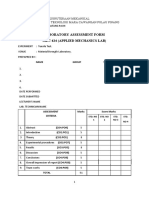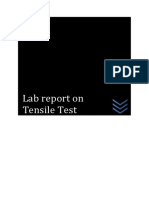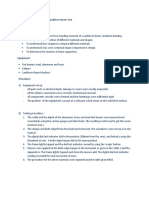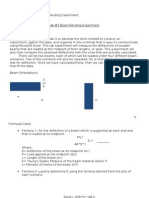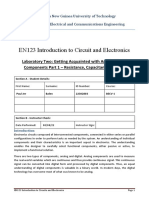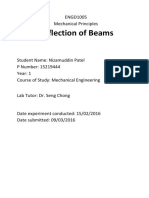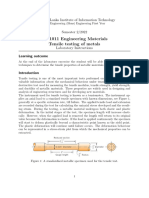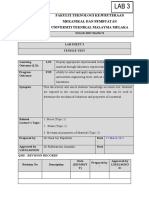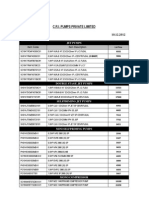Mec 424 - Laboratory Report Tensile Test
Uploaded by
Shameerul AkifMec 424 - Laboratory Report Tensile Test
Uploaded by
Shameerul AkifApplied Mechanics Lab MEC 424
UNIVERSITI TEKNOLOGI MARA
FAKULTI KEJURUTERAAN MEKANIKAL
___________________________________________________________________________
Program
:
Bachelor of Engineering (Hons) Mechanical (EM220/EM221)
Course
:
Applied Mechanics Lab
Code
:
MEC 424
Lecturer
:
Ms. Farhanah Bt. Idris
Group
:
EMD4M5A
___________________________________________________________________________
MEC 424 - LABORATORY REPORT
TITLE
TENSILE TEST
No
NAME
1. MUHAMMAD SHAMEERUL AFIF BIN ABD
HALIM
2. MUHAMMAD SHAMEERUL AKIF BIN ABD
HALIM
3. MUHAMMAD AMIRUL ASYRAF BIN
YAACOB
LABORATORY SESSION
STUDENT ID
2015834428
SIGNATURE
2015828896
2015835092
:
(DATE)
REPORT SUBMISSION
:
(DATE)
*By signing above you attest that you have contributed to this submission and confirm that all work you have contributed to this
submission is your own work. Any suspicion of copying or plagiarism in this work will result in an investigation of academic
msconduct and may result in a 0 on the work, an F in the course, or possibly more severe penalties.
Marking Scheme
No
Total
Applied Mechanics Lab MEC 424
1.0 ABSTRACT
Elastics Modulus is defined as the change in stress when applied the
strain. The experiment was done to elastic modulus (E) of beam specimen
by using the deflection method. The purpose of this tensile test was to
determine the tensile properties of a mild steel specimen when it
undergoes tensile loading. Apart from that types of fracture surface were
identified after specimen was subjected to tensile loading. Data between
experimental
and
theoretical
was
validating.
The
experiment
was
conducted by subjecting the specimen to tensile loading until fracture
occurs. The values for stress and strain were obtained and graph was
plotted. It can be concluded that the specimen exhibited elastic properties
up to the load where necking occurs. After this point the stress increased
until the specimen fractured. From the results obtained, it is indicated that
mild steel has relatively high tensile strength and ductility.
Applied Mechanics Lab MEC 424
2.0 INTRODUCTION
Uniaxial tensile test is known as a basic and universal engineering
test to achieve material parameters. These important parameters obtained
from the standard tensile testing are useful for the selection of engineering
materials for any applications required. This experiment primarily used to
determine the relationship between the average normal stress and average
normal strain in the engineering material used in this experiment which is
Aluminium. The test specimen that is being use have a standard shape
and size. It also has a constant circular cross section with enlarged to
prevent the failure occur at the grips. The measurement that is needed to
be considered is the gauge-length distance and initial cross-sectional area.
Another precaution step that will being use is to place both end of the
specimen in a socket joints to ensure there is no bending occur while
conducting the experiment. The specimen must being stretch at a very
slow, constant rate until it fails. Take the elongation reading, = L-L 0 and
this value will comes out at the screen of the experiment machine.
Manufacturers of metals, including producers of raw material or
finished metal products, need to pass compliance standards before
shipping their product. Tensile testing is imperative for ensuring a safe, high
quality material and avoiding the major liabilities associated with providing
non-compliant products. These actions will keep the end consumer satisfied
and dramatically reduce the chance of failure in the field. Tensile testing
provides data on the integrity and safety of materials, components and
products, helping manufacturers ensure that their finished products are fitfor-purpose and manufactured to the highest quality.
Thus, this specimen which is made out of Aluminium, will undergo
tensile test until failure occurs. From this, tensile properties of the specimen
will be obtained. The types of fracture surface when under tensile loading
Applied Mechanics Lab MEC 424
will also can be figured out. Lastly, the experimental and theoretical data
will be validating by means of comparison.
Applied Mechanics Lab MEC 424
3.0 THEORY
The characteristics of the conventional stress-strain curve can be seen at
the graph stress against strain for aluminium. From the curve, we can
identify four different ways in which the material behaves, depending on the
amount of strain induced in the material.
Figure 2.0 True Stress-Strain diagrams for Aluminium
Point A to y
It is Define as Elastic Region or Elastic Behaviour. It is occurs when the
strains in the specimen are within these two point. Here the curve is
actually a straight line throughout most of this region is said to be linear
plastic. The upper stress limit to this linear relationship is called proportional
limit, pl . If the stress slightly exceeds the proportional limit, the curve tends
to bend and flatten out as shown. This continues until the stress reaches the
elastic limit. Upon reaching this point, if the load is removed the specimen
will still return back to its original shape. Point A in this region is called
proportional limit. Point B is the elastic limit and point y is called yield
stress. This point y is where the elastic modulus, E is being calculated due
to its behaviour as the last point in elastic phase.
Applied Mechanics Lab MEC 424
Point y to u
This is where the Strain Hardening occur. When yielding has ended, an
increase in load can be supported by the specimen, resulting in a curve that
rises continuously but becomes flatter until it reaches a maximum stress
referred to as the, u. The rise in the curve in this manner is called strain
hardening. This point u is called ultimate stress.
Point u to f
This is the region where the Necking occur. Up to the ultimate stress, as the
specimen elongates, its cross-sectional area will decrease. This decrease is
fairly uniform over the specimens entire gauge length; however, just after,
at the ultimate stress, the cross-sectional area will begin to decrease in a
localized region of the specimen. As a result, a constriction or neck tends
to form in this region as the specimen elongates further. Point f is called
fracture stress.
Stress, F/A
Strain, LL
Elastic Modulus, E = Stress, / Strain,
Table 2.0 List of Formulae
Applied Mechanics Lab MEC 424
4.0 APPARATUS
Vernier calliper, tensile test machine, rectangular mild steel specimen,
extension gauge, load gauge, universal magnet holder.
Extension gauge
Universal magnet holder
Load gauge
Aluminium
:
Figure 5.0 Tensile Testing Equipment
Vernier Calliper
Applied Mechanics Lab MEC 424
5.0
PROCEDURES
1. Length of specimen is measured using Vernier calliper
2. The thickness and width of specimen is measured
3. The specimen is mounted to the jaw grip of tensile test machine
4. The extensometer is placed on the vertical flat of inner jaw
5. The load anchor is turned in clockwise direction
6. The extension and load gauges both were reset to 0
7. Then, the extensometer was increased by every 20 until the
specimen broke
and the
load gauge was recorded for every
increment of extension
8. Graph of stress against strain is plotted
6.0 RESULTS
Applied Mechanics Lab MEC 424
Initial length, L0 = 35.42 mm
mm
Width = 3.24mm
LOAD (kN)
X 50N
EXSTENSION
(mm)
STRESS (Pa)
Force
=
Area
0
20
40
60
80
100
120
140
160
180
200
220
240
260
280
300
320
340
360
380
400
420
440
460
480
500
520
540
560
580
600
620
640
0
10.0
15.5
17.0
16.2
17.9
18.1
18.2
18.4
18.8
18.8
19.1
19.2
19.3
19.4
19.5
19.5
19.6
19.6
19.3
19.8
19.8
19.8
19.8
18.8
19.4
19.7
19.4
18.8
17.0
14.9
10.2
5.1
0
308641975.3
617283950.6
925925925.9
1234567901.0
1543209877.0
1851851852.0
2160493827.0
2469135820.0
2777777778.0
3086419753.0
3395061728.0
3703073004.0
4012345679.0
4320987654.0
4629629630.0
4938271605.0
5246913580.0
5555555556.0
5864197531.0
6172839506.0
6481481481.0
6790123457.0
7098765432.0
7407407407.0
7716049383.0
8024691358.0
8333333333.0
8641975309.0
8950617284.0
9259259259.0
9567901235.0
9876543210.0
Table 7.0 Experimental Data
Thickness = 1.0
STRAIN
=
( lo +extension )lo
lo
0
0.2823
0.4376
0.4884
0.4574
0.5054
0.5110
0.5138
0.5195
0.5308
0.5308
0.5392
0.5421
0.5449
0.5477
0.5055
0.5055
0.5334
0.5334
0.5449
0.5590
0.5590
0.5990
0.5990
0.5308
0.5477
0.5562
0.5477
0.5308
0.4884
0.4207
0.2879
0.1439
Applied Mechanics Lab MEC 424
strain vs stress graph
0.8
0.6
Strain
0.4
0.2
0
0
5000000000
10000000000
15000000000
Stress
Graph 1 : strain vs stress graph
Extension vs Load
25
20
15
extension
10
5.1
5
0
0
100
200
300
400
500
load
Graph 2 : extension vs load graph
Sample Calculations
600
700
Applied Mechanics Lab MEC 424
Area, A
= Width x Thickness
= (3.24x10-3) (1.0x10-3)
= 3.24x10-6 m2
Stress,
Force
Area
10
3.24(6)
20 X 50
= 30.864 MPa
Strain,
=
=
( lo +extension )lo
lo
( 0.03542+ 0.01 )0.03542
0.03542
= 0.2823
Elastic Modulus, E =
308641975.3
0.2823
= 109.3304 MPa
Percentage Error =
E T h eoreticalE Experimental
x 100
ET h eoretical
210109.3304
210
x 100 = 47.938%
Applied Mechanics Lab MEC 424
9.0
REFERENCES
1. Elastic Modulus of Aluminum. Retrieved June 15, 2016 from:
http://www.physics.usyd.edu.au/teach_res/db/d0004c.htm
2.
Stress-Strain behavior of Aluminum. Retrieved June 14, 2016 from:
http://www.sciencedirect.com/science/article/pii/S0020768309002716
3. R. C. Hibbeler, Mechanics of Materials, The Stress Strain Diagram, 9th ed,
Pearson,
Singapore, 2014, pp. 85-90
You might also like
- Torsion Lab Report Mechanical EngineeringNo ratings yetTorsion Lab Report Mechanical Engineering13 pages
- Torsion of Rods (Laboratory Practical) 2016100% (1)Torsion of Rods (Laboratory Practical) 20166 pages
- Undamped Free Vibration-Lab Report: Author: Muhammad Sohaib AlamNo ratings yetUndamped Free Vibration-Lab Report: Author: Muhammad Sohaib Alam11 pages
- Experiment 4: Deflection of Cantilever Beam TestNo ratings yetExperiment 4: Deflection of Cantilever Beam Test6 pages
- LAB REPORT BUCKLING OF STRUTS (Reference)No ratings yetLAB REPORT BUCKLING OF STRUTS (Reference)13 pages
- Observing Fracture Mechanics of The Supplied Specimen by Impact TestingNo ratings yetObserving Fracture Mechanics of The Supplied Specimen by Impact Testing11 pages
- Experiment No: 02 Experiment Name: Study and Observation of Tensile Test of A Mild SteelNo ratings yetExperiment No: 02 Experiment Name: Study and Observation of Tensile Test of A Mild Steel9 pages
- Experiment No. 1 Impact Strength of A Material100% (1)Experiment No. 1 Impact Strength of A Material7 pages
- Buckling Test: Mechanical Engineering Laboratory Report100% (1)Buckling Test: Mechanical Engineering Laboratory Report16 pages
- EN123 Lab 2 Getting Acquainted With Analog Circuit Components Part 1 - Resistance, Capacitance & DiodeNo ratings yetEN123 Lab 2 Getting Acquainted With Analog Circuit Components Part 1 - Resistance, Capacitance & Diode6 pages
- Mechanics of Materials Lab Mec424 Bending in Beam: Mr. Suhaime Suparman67% (3)Mechanics of Materials Lab Mec424 Bending in Beam: Mr. Suhaime Suparman12 pages
- ENGD1005 Deflection of Beams Experiment 2015100% (1)ENGD1005 Deflection of Beams Experiment 20156 pages
- Lab Report (Tensile) - Mohd Syazwan Bin Sarudin - 2021836538No ratings yetLab Report (Tensile) - Mohd Syazwan Bin Sarudin - 202183653821 pages
- 23AE60R01 Expt1 AerospaceStructuresLaboratoryNo ratings yet23AE60R01 Expt1 AerospaceStructuresLaboratory7 pages
- 2:5 Design For Cyclic Loading: 1. Completely Reversing Cyclic Stress and Endurance StrengthNo ratings yet2:5 Design For Cyclic Loading: 1. Completely Reversing Cyclic Stress and Endurance Strength8 pages
- Application of Finite Element Method in Structural DesignNo ratings yetApplication of Finite Element Method in Structural Design16 pages
- Termodinamika Technique Jilid 1 Edition 4No ratings yetTermodinamika Technique Jilid 1 Edition 45 pages
- Be Civil 3rd Semester Syllabus1492571380 PDFNo ratings yetBe Civil 3rd Semester Syllabus1492571380 PDF17 pages
- EgyE 201 Assignment On Energy Conversion SystemsNo ratings yetEgyE 201 Assignment On Energy Conversion Systems2 pages
- May 2000 Structural Engineering and Construction 2No ratings yetMay 2000 Structural Engineering and Construction 228 pages
- 2024_11.Compact power. The ecoGEO+ LITE 1-6 PRO. A solution for any spaceNo ratings yet2024_11.Compact power. The ecoGEO+ LITE 1-6 PRO. A solution for any space35 pages
- Hydraulic and Pneumatic Actuators 1 PDFNo ratings yetHydraulic and Pneumatic Actuators 1 PDF109 pages
- Physicsprojectclass11 230107021548 6955d3cdsaNo ratings yetPhysicsprojectclass11 230107021548 6955d3cdsa14 pages
- United States Patent: Gysling Et Al. (45) Date of Patent: Dec. 26, 2006No ratings yetUnited States Patent: Gysling Et Al. (45) Date of Patent: Dec. 26, 200631 pages
- Two-Phase Condensation Heat Transfer Models100% (1)Two-Phase Condensation Heat Transfer Models14 pages
- 503-10. 21.10. Lap PIT PROYEK OVERPASS KADUSIRUNG 1 (Abt.1t bp.18)No ratings yet503-10. 21.10. Lap PIT PROYEK OVERPASS KADUSIRUNG 1 (Abt.1t bp.18)20 pages
- Dynamic Behaviour of Concrete Structures Subjected To Blast and Fragment ImpactsNo ratings yetDynamic Behaviour of Concrete Structures Subjected To Blast and Fragment Impacts96 pages
- Undamped Free Vibration-Lab Report: Author: Muhammad Sohaib AlamUndamped Free Vibration-Lab Report: Author: Muhammad Sohaib Alam
- Observing Fracture Mechanics of The Supplied Specimen by Impact TestingObserving Fracture Mechanics of The Supplied Specimen by Impact Testing
- Experiment No: 02 Experiment Name: Study and Observation of Tensile Test of A Mild SteelExperiment No: 02 Experiment Name: Study and Observation of Tensile Test of A Mild Steel
- Buckling Test: Mechanical Engineering Laboratory ReportBuckling Test: Mechanical Engineering Laboratory Report
- EN123 Lab 2 Getting Acquainted With Analog Circuit Components Part 1 - Resistance, Capacitance & DiodeEN123 Lab 2 Getting Acquainted With Analog Circuit Components Part 1 - Resistance, Capacitance & Diode
- Mechanics of Materials Lab Mec424 Bending in Beam: Mr. Suhaime SuparmanMechanics of Materials Lab Mec424 Bending in Beam: Mr. Suhaime Suparman
- Lab Report (Tensile) - Mohd Syazwan Bin Sarudin - 2021836538Lab Report (Tensile) - Mohd Syazwan Bin Sarudin - 2021836538
- Handbook of Mechanical and Materials EngineeringFrom EverandHandbook of Mechanical and Materials Engineering
- 2:5 Design For Cyclic Loading: 1. Completely Reversing Cyclic Stress and Endurance Strength2:5 Design For Cyclic Loading: 1. Completely Reversing Cyclic Stress and Endurance Strength
- Application of Finite Element Method in Structural DesignApplication of Finite Element Method in Structural Design
- May 2000 Structural Engineering and Construction 2May 2000 Structural Engineering and Construction 2
- 2024_11.Compact power. The ecoGEO+ LITE 1-6 PRO. A solution for any space2024_11.Compact power. The ecoGEO+ LITE 1-6 PRO. A solution for any space
- United States Patent: Gysling Et Al. (45) Date of Patent: Dec. 26, 2006United States Patent: Gysling Et Al. (45) Date of Patent: Dec. 26, 2006
- 503-10. 21.10. Lap PIT PROYEK OVERPASS KADUSIRUNG 1 (Abt.1t bp.18)503-10. 21.10. Lap PIT PROYEK OVERPASS KADUSIRUNG 1 (Abt.1t bp.18)
- Dynamic Behaviour of Concrete Structures Subjected To Blast and Fragment ImpactsDynamic Behaviour of Concrete Structures Subjected To Blast and Fragment Impacts





